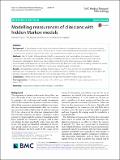Files in this item
Modelling reassurances of clinicians with Hidden Markov models
Item metadata
| dc.contributor.author | Popov, Valentin | |
| dc.contributor.author | Ellis-Robinson, Alesha | |
| dc.contributor.author | Humphris, Gerald | |
| dc.date.accessioned | 2019-01-10T10:30:06Z | |
| dc.date.available | 2019-01-10T10:30:06Z | |
| dc.date.issued | 2019-01-09 | |
| dc.identifier | 256683023 | |
| dc.identifier | 315aa5be-dd84-41cc-ab1c-0af00ed077dd | |
| dc.identifier | 85059797065 | |
| dc.identifier | 000455355600004 | |
| dc.identifier.citation | Popov , V , Ellis-Robinson , A & Humphris , G 2019 , ' Modelling reassurances of clinicians with Hidden Markov models ' , BMC Medical Research Methodology , vol. 19 , 11 . https://doi.org/10.1186/s12874-018-0629-0 | en |
| dc.identifier.issn | 1471-2288 | |
| dc.identifier.other | ORCID: /0000-0002-4601-8834/work/64033907 | |
| dc.identifier.uri | https://hdl.handle.net/10023/16829 | |
| dc.description | Generous support was received from the charity Breast Cancer Now (grant number: 6873) | en |
| dc.description.abstract | Background: A key element in the interaction between clinicians and patients with cancer is reassurance giving. Learning about the stochastic nature of reassurances as well as making inferential statements about the influence of covariates such as patient response and time spent on previous reassurances are of particular importance. Methods: We fit Hidden Markov Models (HMMs) to reassurance type from multiple time series of clinicians' reassurances, decoded from audio files of review consultations between patients with breast cancer and their therapeutic radiographer. Assuming a latent state process driving the observations process, HMMs naturally accommodate serial dependence in the data. Extensions to the baseline model such as including covariates as well as allowing for fixed effects for the different clinicians are straightforward to implement. Results: We found that clinicians undergo different states, in which they are more or less inclined to provide a particular type of reassurance. The states are very persistent, however switches occasionally occur. The lengthier the previous reassurance, the more likely the clinician is to stay in the current state. Conclusions: HMMs prove to be a valuable tool and provide important insights for practitioners. Trial registration: Trial Registration number: ClinicalTrials.gov: NCT02599506. Prospectively registered on 11th March 2015. | |
| dc.format.extent | 10 | |
| dc.format.extent | 1481474 | |
| dc.language.iso | eng | |
| dc.relation.ispartof | BMC Medical Research Methodology | en |
| dc.subject | Reassurance | en |
| dc.subject | Hidden Markov models | en |
| dc.subject | Fixed effects | en |
| dc.subject | QA Mathematics | en |
| dc.subject | NDAS | en |
| dc.subject | SDG 3 - Good Health and Well-being | en |
| dc.subject.lcc | QA | en |
| dc.title | Modelling reassurances of clinicians with Hidden Markov models | en |
| dc.type | Journal article | en |
| dc.contributor.institution | University of St Andrews. Centre for Research into Ecological & Environmental Modelling | en |
| dc.contributor.institution | University of St Andrews. Statistics | en |
| dc.contributor.institution | University of St Andrews. Population and Behavioural Science Division | en |
| dc.contributor.institution | University of St Andrews. WHO Collaborating Centre for International Child & Adolescent Health Policy | en |
| dc.contributor.institution | University of St Andrews. Health Psychology | en |
| dc.contributor.institution | University of St Andrews. St Andrews Sustainability Institute | en |
| dc.contributor.institution | University of St Andrews. School of Medicine | en |
| dc.contributor.institution | University of St Andrews. Sir James Mackenzie Institute for Early Diagnosis | en |
| dc.identifier.doi | https://doi.org/10.1186/s12874-018-0629-0 | |
| dc.description.status | Peer reviewed | en |
| dc.date.embargoedUntil | 2019-01-09 |
This item appears in the following Collection(s)
Items in the St Andrews Research Repository are protected by copyright, with all rights reserved, unless otherwise indicated.

